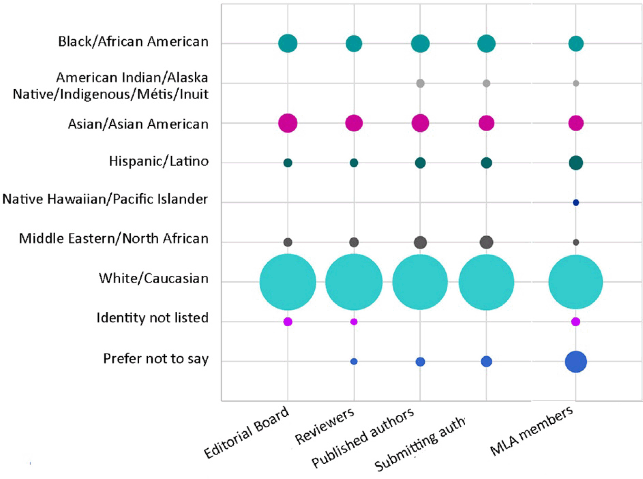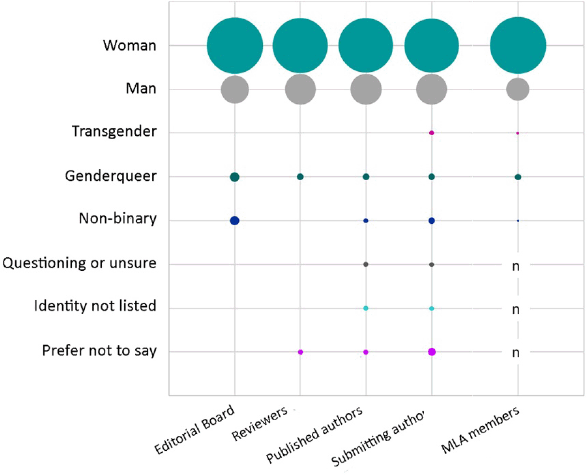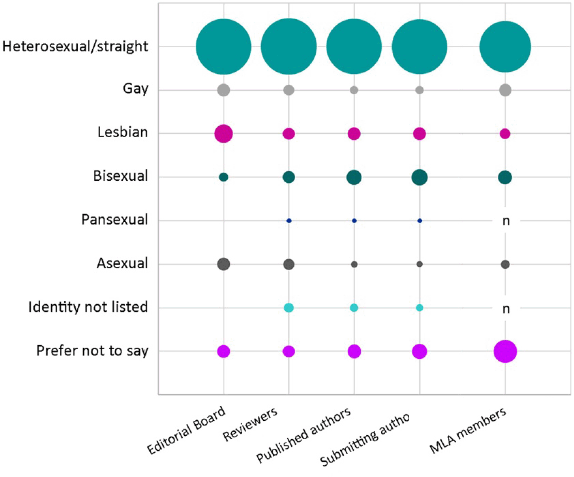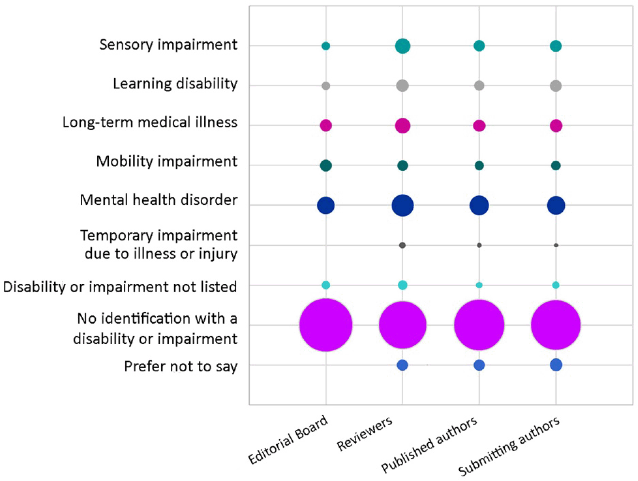Editorial
Racial, gender, sexual, and disability identities of the Journal of the Medical Library
Association's editorial board, reviewers, and authors
Katherine G. Akers1, JJ Pionke2, Ellen M. Aaronson, AHIP3, Thane Chambers4, John W. Cyrus5, Erin R.B. Eldermire6, Melanie J. Norton7
doi: http://dx.doi.org/10.5195/jmla.2021.1216
Volume 109, Number 2: 167-173
Received 01 2021:
Accepted 01 2021
ABSTRACT
The Journal of the Medical Library Association (JMLA) recently issued a call for submissions that recognize and address social injustices;
speak to diversity, equity, and inclusion in our workforce and among our user populations;
and share critical perspectives on health sciences librarianship as well as those
on any topic within JMLA's scope written by authors who are Black, Indigenous, or People of Color. We also
committed to creating more equitable opportunities for authors, reviewers, and editorial
board members from marginalized groups. As part of this effort, we conducted a demographic
survey of all individuals who served as a member of the JMLA editorial board or reviewer or had submitted a manuscript to JMLA between 2018 and 2020. We found that most survey respondents are white, heterosexual,
women and do not identify with a disability, meaning that JMLA is missing out on a diversity of perspectives and life experiences that could improve
the journal's processes and policies, enrich its content, and accelerate the research
and practice of health sciences librarianship. Therefore, to avoid perpetuating or
aggravating systemic biases and power structures in scholarly publishing or health
sciences librarianship, we pledge to take concrete steps toward making JMLA a more diverse and inclusive journal.
INTRODUCTION
Scholarly publishing is rife with systemic inequities and biases against contributors
and content not representative of the majority voice [1, 2], which, in librarianship, belongs to white, middle-aged women without disabilities
[3]. Recognizing that race, gender, and other personal characteristics impact who can
publish, what can be published, and who gets to make the decisions, many peer-reviewed
journals have made statements and taken action to increase the diversity and inclusiveness
of their editorial boards, policies and processes, authors and reviewers, and published
works (e.g., Flaherty [4] and Journal of Librarianship and Scholarly Communication editors and editorial board [5]). The Journal of the Medical Library Association (JMLA) is one of those journals.
In the summer of 2020, motivated by national conversations around Black Lives Matter,
systemic racism, police violence, and health disparities laid bare by the COVID-19
pandemic, the JMLA team affirmed our commitment to promoting diversity and equity in health sciences
librarianship and information science. We issued a call for submissions that recognize
and address social injustices; speak to diversity, equity, and inclusion in our workforce
and among our user populations; and share critical perspectives on health sciences
librarianship as well as those on any topic within JMLA's scope written by Black, Indigenous, and People of Color (BIPOC) authors [6]. Along with this call for submissions, we committed to specific actions aimed at
increasing our understanding of systemic bias in scholarly publishing and creating
more equitable opportunities for authors, reviewers, and editorial board members from
marginalized groups. This work is led by a designated JMLA equity workgroup with liaisons to key caucuses, committees, and boards within the
Medical Library Association (MLA).
To assess the racial diversity of recent JMLA authors, peer reviewers, and editorial board members and obtain baseline data for
evaluating our efforts to incorporate and amplify the contributions and voices of
our BIPOC colleagues, we surveyed all individuals who had served as a JMLA editorial board member or reviewer or had submitted a manuscript to JMLA between 2018 and 2020. In addition to assessing racial identity, we also took this
opportunity to obtain data on gender, sexual, and disability identities and inquire
about barriers to publishing in or working with JMLA experienced by recent authors, peer reviewers, and editorial board members.
DEMOGRAPHIC SURVEY
We iteratively developed a survey instrument with input from all JMLA equity workgroup members (supplemental appendix). Our target population was individuals who served as a JMLA editorial board member (n=85), reviewed a manuscript submitted to JMLA (n=433), or submitted a manuscript to JMLA (including all manuscript coauthors, n=905) between 2018 and 2020. After de-duplicating
the names of individuals who engaged with JMLA in more than 1 role, our population consisted of 1,156 unique individuals. With the
assistance of MLA staff, a link to the survey in REDCap was sent to the email addresses
of the 1,156 individuals on December 1, 2020. The survey closed on December 15, 2020,
after email reminders were sent to nonresponders. No identifying information was collected
in the survey, and respondents were assured that survey data would only be reported
in aggregate.
A total of 290 respondents completed the survey; 46 indicated they had been an editorial
board member (54% response rate), 162 had served as a reviewer (37% response rate),
and 196 had submitted a manuscript to JMLA (22% response rate). For analysis and reporting purposes, we categorized authors
into 2 non-mutually exclusive groups: “submitting authors” (n=196), defined as authors
who submitted a manuscript regardless of the editorial decision, and “published authors”
(n=167), defined as authors whose manuscripts were accepted and published. Therefore,
the “published authors” group was a subset of the larger “submitting authors” group.
Closed-ended responses were analyzed with descriptive statistics and visualized using
bubble plots, in which the size of the circle indicates the percentage of respondents
within a certain group. For comparative purposes, we include corresponding demographic
data for MLA members [7] within the bubble plots when available. However, we caution against making direct
comparisons between our survey responses and MLA members, as most JMLA authors [8], many reviewers, and some editorial board members are not members of MLA. Open-ended
responses were analyzed using informal thematic analysis.
Racial identity
Respondents were asked to select their racial identity from a predefined list, with
multiple selections allowed. Editorial board members, reviewers, published authors,
and submitting authors were predominantly White/Caucasian (78%, 80%, 77%, and 78%,
respectively; Figure 1). Smaller proportions of editorial board members, reviewers, published authors, and
submitting authors were Black/African American (9%, 7%, 8%, and 8%) or Asian/Asian
American (9%, 7%, 8%, and 7%). Few editorial board members, reviewers, published authors,
and submitting authors were Middle Eastern/North African (2%, 2%, 4%, and 5%), Hispanic/Latino
(2%, 2%, 3%, and 3%), or American Indian/Alaska Native/Indigenous/Métis/Inuit (0,
0, 2%, and 2%). No respondents were Native Hawaiian/Pacific Islander (0, 0, 0, and
0). Some editorial board members, reviewers, published authors, and submitting authors
indicated that they had a racial identity not listed (2%, 1%, 0, and 0) or preferred
not to state their racial identity (0, 1%, 2%, and 3%). The racial identity composition
of JMLA affiliates was largely similar to that of MLA members.
Figure 1
Racial identity of Journal of the Medical Library Association (JMLA) editorial board members, reviewers, and published and submitting authors (compared
with MLA members [7])

Within each group along the y-axis, the size of the bubbles indicates the percentage
of respondents who selected each identity.
Gender identity
Respondents were asked to select their gender identity from a predefined list, with
multiple selections allowed. Editorial board members, reviewers, published authors,
and submitting authors were predominantly women (78%, 75%, 74%, and 72%, respectively)
(Figure 2). A smaller proportion of editorial board members, reviewers, published authors,
and submitting authors were men (20%, 23%, 24%, and 23%). Few editorial board members,
reviewers, published authors, and submitting authors were genderqueer (2%, 1%, 1%,
and 1%), non-binary (2%, 0, 1%, and 1%), or transgender (0, 0, 0, and 1%). Some editorial
board members, reviewers, published authors, and submitting authors indicated that
they had a gender identity not listed (0, 0, 1%, and 1%) or preferred not to state
their gender identity (0, 1%, 1%, and 2%). The gender identity composition of JMLA affiliates was largely similar to that of MLA members.
Figure 2
Gender identity of JMLA editorial board members, reviewers, and published and submitting authors (compared
with MLA members [7])

Within each group along the y-axis, the size of the bubbles indicates the percentage
of respondents who selected each identity. n=not available.
Sexual identity
Respondents were asked to select their sexual identity from a predefined list, with
multiple selections allowed. Editorial board members, reviewers, published authors,
and submitting authors were predominantly heterosexual/straight (80%, 81%, 79%, and
78%, respectively) (Figure 3). Much smaller proportions of editorial board members, reviewers, published authors,
and submitting authors were lesbian (9%, 4%, 4%, and 4%), bisexual (2%, 4%, 6%, and
7%), gay (4%, 3%, 2%, and 2%), asexual (4%, 3%, 1%, and 1%), or pansexual (0%, 1%,
1%, and 1%). Some editorial board members, reviewers, published authors, and submitting
authors indicated that they had a sexual identity not listed (0, 2%, 2%, and 2%) or
preferred not to state their sexual identity (4%, 4%, 5%, and 6%). The sexual identity
composition of JMLA affiliates was largely similar to that of MLA members.
Figure 3
Sexual identity of JMLA editorial board members, reviewers, and published and submitting authors (compared
with MLA members [7])

Within each group along the y-axis, the size of the bubbles indicates the percentage
of respondents who selected each identity. n=not available.
Disability identity
Respondents were asked to select their disability identity from a predefined list,
with multiple selections allowed. Most editorial board members, reviewers, published
authors, and submitting authors did not identify with a disability or impairment (80%,
65%, 74%, and 72%, respectively) (Figure 4). Of the disability identities listed, the most common was mental health disorders
(9%, 14%, 11%, and 10%), followed by long-term medical illnesses such as epilepsy
or cystic fibrosis (4%, 7%, 4%, and 5%); sensory impairments such as vision or hearing
impairment (2%, 7%, 4%, and 4%); learning disabilities such as attention deficit hyperactivity
disorder (ADHD) and dyslexia (2%, 4%, 3%, and 4%); mobility impairments (4%, 3%, 2%,
and 3%); and temporary impairments due to illness or injury such as a broken ankle
or surgery (0, 1%, 1%, and 1%). Some editorial board members, reviewers, published
authors, and submitting authors indicated that they had a disability or impairment
not listed (2%, 2%, 1%, and 2%) or preferred not to state their disability identity
(0, 4%, 4%, and 5%). The disability identity composition of JMLA affiliates was not compared to that of MLA members due to the unavailability of detailed
reporting on MLA members [7].
Figure 4
Disability identity of JMLA editorial board members, reviewers, and published and submitting authors

Within each group along the y-axis, the size of the bubbles indicates the percentage
of respondents who selected each identity.
Barriers to working with JMLA
The final survey item was an open-ended prompt to “Describe any barriers you have
experienced to publishing in or working with JMLA,” to which 89 respondents provided relevant responses. Of these 89 respondents, 46
(52%) said that they encountered no barriers to publishing in or working with JMLA, with several individuals stating that they experienced a smooth publishing process,
were treated professionally, and/or found the editors to be helpful and supportive.
Ten (11%) respondents said that the only barriers they encountered were workplace
or personal barriers, such as lack of research support, time, experience, or knowledge
of the publishing process.
Other respondents identified barriers specific to JMLA. Seven (8%) respondents said that JMLA's reviewers were unprofessional, too nit-picky, or untrained. Seven (8%) respondents
commented on subjectivity in the reviewers’ comments or editors’ decisions, sometimes
leading to decisions to decline a manuscript without sufficient rationale or based
on its perceived lack of fit to JMLA's scope, lack of novelty, or narrow geographical focus on non-US countries. Four
respondents each said that JMLA did not do enough outreach to professionals in the field, particularly new librarians
(5%); JMLA was too focused on articles describing research and/or certain topics (5%); and JMLA's standards were too high (5%). Three (3%) respondents found the JMLA submission system to be complicated or confusing. Two (2%) respondents said that
the manuscript revision process was too burdensome. One respondent each said that
the author guidelines were too cumbersome (1%); making changes to article proofs was
too difficult (1%); editors were not sufficiently skilled in editing manuscripts covering
topics related to diversity, equity, and inclusion (1%); and the editorial board member
selection process was not transparent (1%).
CONCLUSIONS
We found that JMLA editorial board members, reviewers, and authors are mostly white, heterosexual women
without disabilities or impairments, similar to the demographic characteristics of
the MLA membership [7], academic librarianship [9], and librarianship as a whole [3]. While this finding is not surprising, it suggests that JMLA lacks representation and contributions from individuals who are not white, who are
LGBTQ+, or who have disabilities or impairments that influence their views of, or
approach to, health sciences librarianship. In other words, JMLA is missing out on a diversity of perspectives and life experiences that would continuously
improve the journal's processes and policies, enrich its content, and accelerate the
research and practice of health sciences librarianship. Therefore, we commit to developing
concrete strategies and programs to become more inclusive of new voices and topics,
to diversify JMLA's content and contributors, and to create more equitable opportunities for JMLA authors, reviewers, and editorial board members.
Although most survey respondents indicated that they did not experience barriers to
working with or publishing in JMLA, this does not prove that such barriers do not exist. Rather, it is likely that most
respondents occupy positions of privilege due to their racial, gender, sexual, or
disability identities and thus do not experience barriers that may stand in the way
of people from marginalized groups. It is possible that individuals who encountered
barriers to working with or publishing in JMLA were less likely to respond to our survey. Furthermore, individuals who may have
encountered significant barriers preventing them from submitting to or serving in
a volunteer role for JMLA would not have received a survey invitation. Therefore, to acquire additional feedback
from a broader contingent of JMLA readers and potential authors, reviewers, and editorial board members, we will create
an anonymous virtual suggestion box, available through the JMLA website, and plan to conduct another survey on barriers to publishing in or working
with JMLA among all MLA members regardless of their role, or lack thereof, with JMLA.
Of the barriers to working with or publishing in JMLA mentioned by survey respondents, some might be expected regardless of the journal
(e.g., lack of time to conduct research or write), and some could be related to JMLA's premier status in the field (e.g., high standards for manuscript acceptance). However,
other barriers could be products of implicit bias or structural discrimination that
must be recognized and dismantled. In particular, we suspect that the respondent who
stated that JMLA editors were not sufficiently skilled in editing manuscripts on topics related to
diversity, equity, and inclusion spoke directly to our recent failure [10–12] to appropriately honor the voices or experiences of BIPOC authors seeking to publish
an editorial on anti-Blackness in libraries [13]. This mistake shines a spotlight on the urgent need to (1) educate our editorial
team about how our actions or inactions continue to perpetuate systemic racism and
white supremacy within scholarly publishing; (2) interrogate internal JMLA workflows to identify and remove barriers that impede contributions from, or engagement
with, BIPOC individuals; and (3) actively seek to build trust among, and form stronger
partnerships with, communities of BIPOC individuals and other people who are often
marginalized due to their racial, gender, sexual, or disability identities.
Charlotte Roh, scholarly communications librarian at the University of San Francisco,
pointedly asks, “As librarians who are engaging more directly with scholarly publishing,
we must ask ourselves: Are we perpetuating the biases and power structures of traditional
scholarly publishing?” [1]. We steadfastly do not want JMLA to perpetuate or exaggerate systemic biases and power structures in scholarly publishing
or health sciences librarianship and pledge to continue working to make JMLA a more diverse and inclusive journal with equitable opportunities for authors, reviewers,
and editorial board members. In particular, we thank JMLA's stakeholders for providing valuable guidance toward identifying and removing barriers
to publishing that may stem from unconscious racism or other forms of discrimination
[14], which we are actively using to scrutinize and improve our policies and procedures.
ACKNOWLEDGMENTS
We thank Jill Barr-Walker for contributing to survey design and implementation and
Amy Reyes, AHIP, Brenda M. Linares, AHIP, and Kelsa Bartley for critical comments
on this editorial.
SUPPLEMENTAL FILE
Appendix: Journal of the Medical Library Association's editorial board, reviewer, and author survey
REFERENCES
1. Roh C. Library publishing and diversity values: changing scholarly publishing through policy
and scholarly communication education. Coll Res Libr News. 2016 Feb;77(2):82–5.
2. Williams MT. Racism in academic publishing: observations about race and peer review from a Black
female professor. Psychol Today [Internet]. 14 Jul 2020 [cited 11 Jan 2021]. <https://www.psychologytoday.com/us/blog/culturally-speaking/202007/racism-in-academic-publishing>.
3. Rosa K, Henke K. 2017 ALA demographic study [Internet]. American Library Association [cited 11 Jan 2021]. <http://www.ala.org/tools/research/initiatives/membershipsurveys>
4. Flaherty C. ‘Decolonizing’ a journal. Inside Higher Ed [Internet]. 31 Jan 2018 [cited 11 Jan 2021]. <https://www.insidehighered.com/news/2018/01/31/after-major-flap-historys-premier-journal-announces-series-changes-aimed>.
5. Journal of Librarianship and Scholarly Communication (JLSC) Editors and Editorial
Board. A commitment to anti-racism, diversity, equity, and inclusion from JLSC. J Librariansh Sch Comm. 2020 Sep 18;8(1):p.eP2398. http://dx.doi.org/http://dx.doi.org/10.7710/2162-3309.2398
 .
.
6. Akers KG. JMLA call for submissions and commitment to equity. MLAConnect [Internet]. 27 Aug 2020 [cited 11 Jan 2021]. <https://www.mlanet.org/blog/jmla-call-for- submissions-and-commitment-to-equity>.
7. Pionke JJ. Medical Library Association Diversity and Inclusion Task Force 2019 survey report. J Med Libr Assoc. 2020 Jul;108(3):503–12. DOI: http://dx.doi.org/http://dx.doi.org/10.5195/jmla.2020.948
 .
.
8. Reznik-Zellen R, Carroll AJ, Harrington EG, Joubert DJ, Nix T, Alpi KM. Building visualization skills through investigating the Journal of the Medical Library
Association coauthorship network from 2006–2017. J Med Libr Assoc. 2020 Apr;108(2):229–41. DOI: http://dx.doi.org/http://dx.doi.org/10.5195/jmla.2020.775
 .
.
9. Frederick JK, Wolff-Eisenberg C. Ithaka S+R US library survey 2019 [Internet]. Ithaka S+R; 2 Apr 2020 [cited 11 Jan 2021]. <https://sr.ithaka.org/publications/ithaka-sr-us-library-survey-2019/>.
10. Minter CIJ. A case study on anti-Black publishing practices [Internet]. Minter; 11 Dec 2020 [cited 11 Jan 2021]. <https://christianminter.com/2020/12/11/a-case-study-on-anti-black-publishing-practices/>.
11. Williams J. When publishing goes wrong. The Diversity Fellow's Blog [Internet]. 12 Dec 2020 [cited 11 Jan 2021]. <https://diversityfellow.blog/2020/12/12/when-publishing-goes-wrong/>.
12. Akers K. An apology from JMLA [Internet]. Akers; 16 Dec 2020 [cited 11 Jan 2021]. <http://jmla.mlanet.org/ojs/jmla/announcement/view/7>.
13. Ossom-Williamson P, Williams J, Goodman X, Minter CIJ, Logan A. Starting with I: combating anti-Blackness in libraries [Internet]. Leon S. McGoogan Health Sciences Library; 9 Dec 2020 [cited 11 Jan 2021]. <https://digitalcommons.unmc.edu/mcgoogan_articles/9/>.
14. An open call for JMLA and medical librarianship to support Black colleagues [Internet]. 16 Dec 2020 [cited 11 Jan 2021]. <https://docs.google.com/document/d/1lSr832zT2YLKrAQVUl2a0daYad4EtvFK1GI1QY2StsU/edit>.
Katherine G. Akers, 1 JMLA@journals.pitt.edu, Editor-in-Chief, Journal of the Medical Library Association
JJ Pionke, 2 pionke@illinois.edu, University Library, University of Illinois at Urbana-Champaign, Urbana, IL
Ellen M. Aaronson, AHIP3 aaronson.ellen@mayo.edu, Mayo Clinic Libraries, Mayo Clinic, Rochester, MN
Thane Chambers, 4 thane@ualberta.ca, Cameron Library, University of Alberta, Edmonton, AB, Canada
John W. Cyrus, 5 cyrusjw@vcu.edu, Tompkins-McCaw Library for the Health Sciences, Virginia Commonwealth University,
Richmond, VA
Erin R.B. Eldermire, 6 erb29@cornell.edu, Flower-Sprecher Veterinary Library, Cornell University, Ithaca, NY
Melanie J. Norton, 7 melanie.norton@yale.edu, Cushing/Whitney Medical Library, Yale University, New Haven, CT
Copyright © 2021 Katherine G. Akers, JJ Pionke, Ellen M. Aaronson, Thane Chambers,
John W. Cyrus, Erin R.B. Eldermire, Melanie J. Norton
This work is licensed under a Creative Commons Attribution 4.0 International License.
Journal of the Medical Library Association, VOLUME 109, NUMBER 2, April 2021




